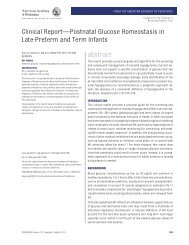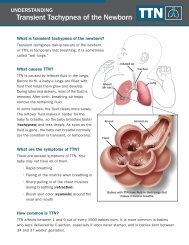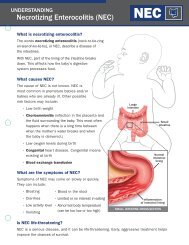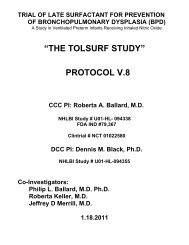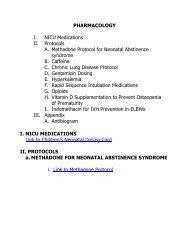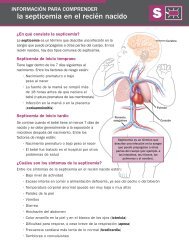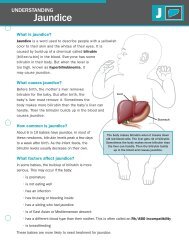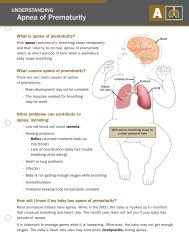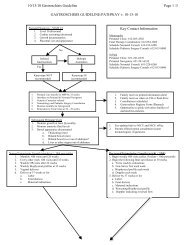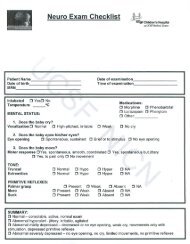Sepsis in Newborns - Associates in Newborn Medicine
Sepsis in Newborns - Associates in Newborn Medicine
Sepsis in Newborns - Associates in Newborn Medicine
You also want an ePaper? Increase the reach of your titles
YUMPU automatically turns print PDFs into web optimized ePapers that Google loves.
UNDERSTANDING<strong>Sepsis</strong> <strong>in</strong> <strong><strong>Newborn</strong>s</strong>SWhat is sepsis?<strong>Sepsis</strong> is a term for a blood <strong>in</strong>fection that can spread to other partsof the body. In newborns, there are two common types of sepsis.Bra<strong>in</strong>Early onset sepsisOccurs with<strong>in</strong> 7 days of birth. Risk factors <strong>in</strong>clude:• Premature birth or low birth weight• Mother’s water broke more than 18hours before birth (premature ruptureof the membranes)• Infection <strong>in</strong> the mother or <strong>in</strong> theplacenta (chorioamnionitis)Late onset sepsisDevelops when the baby is at least 7 days old, and isusually due to exposure to germs after birth.Risk factors <strong>in</strong>clude:• Premature birth or low birth weight• Baby treated for other health problems <strong>in</strong>the hospitalWhat are the symptoms of sepsis?Symptoms of sepsis <strong>in</strong> newborns can <strong>in</strong>clude:• Low activity levelBloodstream• Limited <strong>in</strong>terest <strong>in</strong> eat<strong>in</strong>g or poor feed<strong>in</strong>g from breast or bottle• Abnormal body temperature (can be too low or too high)• Pale sk<strong>in</strong> color• Vomit<strong>in</strong>g• Diarrhea• Bloat<strong>in</strong>g• Yellow color of the sk<strong>in</strong> and the whites of the eyes (jaundice)• Trouble breath<strong>in</strong>g, or a brief stop <strong>in</strong> breath<strong>in</strong>g (apnea)• Decreased heart rate (bradycardia)• Tremors or seizuresLung<strong>Sepsis</strong> is a term used to describean <strong>in</strong>fection <strong>in</strong> the blood that mayspread to other parts of the body(for example, <strong>in</strong>test<strong>in</strong>es, kidneys,lungs, and bra<strong>in</strong>)Heart
Treat<strong>in</strong>g <strong>Sepsis</strong>Does sepsis cause long-term problems?When treated, most newborns recover from sepsis. However,some babies develop complications such as men<strong>in</strong>gitis (<strong>in</strong>fectionof the tissue around the bra<strong>in</strong> and sp<strong>in</strong>al cord) or pneumonia.These complications may result <strong>in</strong> longer hospital stays and ahigher risk for long-term problems. The NICU team will watchyour baby for signs of these problems. Early treatment of sepsiscan help prevent these other <strong>in</strong>fections.What treatment will my baby receive?<strong><strong>Newborn</strong>s</strong> with sepsis are treated with antibiotics.Sicker babies may also receive:• Intravenous (IV) fluids• Extra oxygen – usually given through a nose tube or a mask• Mechanical ventilation – a mach<strong>in</strong>e that helps your babybreathe us<strong>in</strong>g a tubeHow will I know how my baby is do<strong>in</strong>g?Your health care team will keep you up to date on your baby'sprogress. They will watch the baby’s vital signs (such asheart rate, breath<strong>in</strong>g, and temperature). They may also takeblood samples to see if the <strong>in</strong>fection is improv<strong>in</strong>g.What will happen next?Many babies respond well to treatment for sepsis; however,each baby is different. Talk to your baby’s health care team.They can answer any questions you have about your baby.GlossaryAntibiotics – medic<strong>in</strong>es thatfight <strong>in</strong>fections caused by bacteriaApnea – brief stop <strong>in</strong> breath<strong>in</strong>gBradycardia – decreased heart rateChorioamnionitis[kor-e-o-am-nee-o-ni-tis] – <strong>in</strong>fectionof the placenta and the fluidsurround<strong>in</strong>g the babyCulture – a sample of blood,ur<strong>in</strong>e, or other body fluid that iscollected and tested for <strong>in</strong>fectionJaundice – yellow color of thesk<strong>in</strong> and the whites of the eyesMen<strong>in</strong>gitis [men-<strong>in</strong>-jahy-tis] –<strong>in</strong>fection of the tissue around thebra<strong>in</strong> and sp<strong>in</strong>al cordPneumonia [noo-mohn-yuh] –<strong>in</strong>fection of the lungsVentilator – a mach<strong>in</strong>e that helpsyour baby breathe by push<strong>in</strong>g air<strong>in</strong> and out of the lungsAsk the health care team whenyou have questions—they arethere to help.NOTES:______________________________________________________________________________________________________________________________________________________________________________________________________________________________________________________________________________________________________________________________________________________________________________________________________________________________________________________________________________________________________________________________________________________________________________________________________________________________________________________Signature: __________________________________________ Date:__________________ Time: ____________© 2011 Ikaria, Inc. IMK111-01432 September 2011




